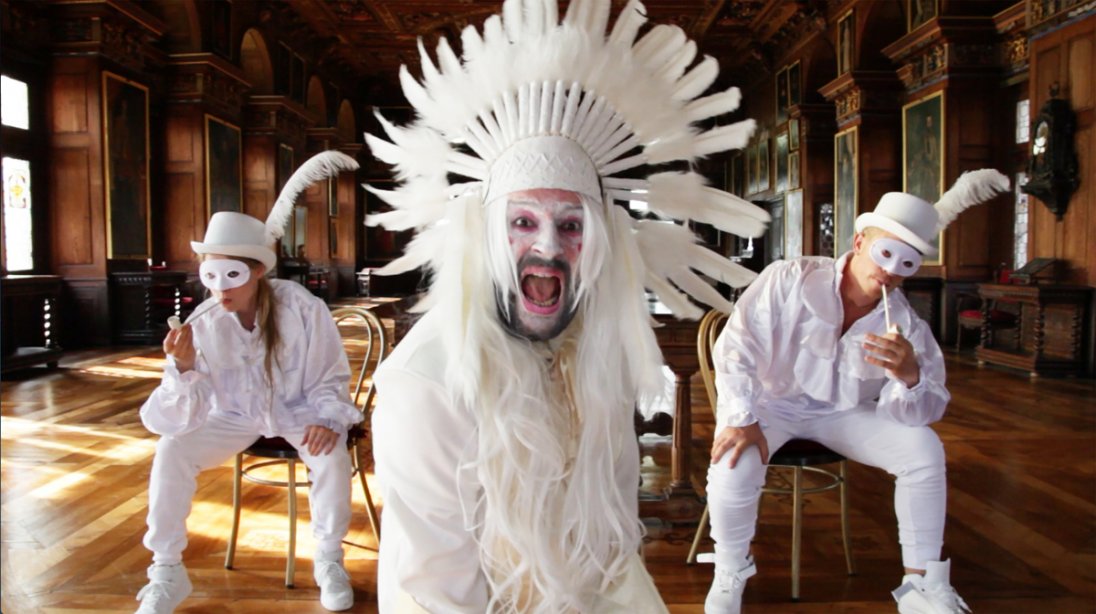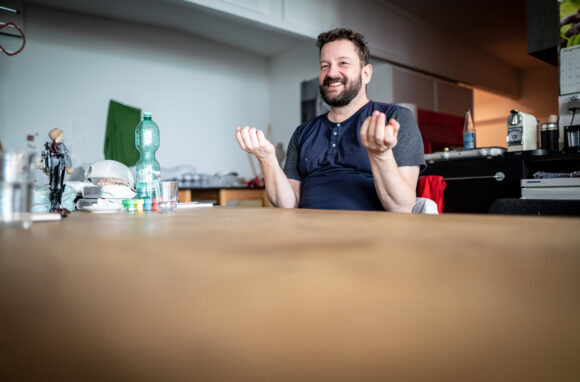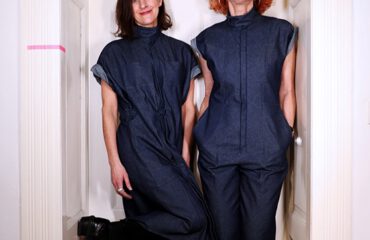Studio-Photos: Markus Schwer
Cologne, September 2018. How magical was the installation of his works at Art Cologne’s this year! I was fascinated by their playfully nostalgic, seemingly light-footed aesthetics; these figures, without exception, had awakened an almost childlike spirit of discovery in me. What was it about the devilish figures of the wall-work, holding the pendulum of the grandfather’s clock, grinning at me so provocatively? The wooden silhouette figures, on closer inspection, turned out to be anything but light-footed. Not only was a hand halted, but also time. A cut made for an end or a new beginning. Such interplay, disclosing profound stories against an apparently harmless backdrop, is typical of Claus Richter’s art, as I will experience on my visit to the studio today …
Gleichbleibender Reiz (2018), wood, varnish, acrylic, 140 x 140 x 5,5 cm
In the centre of Cologne, quietly located in the backyard of an apartment building, is his studio. A kind of eat-in kitchen forms the entrance, which leads into a mixture of warehouse and creative workshop, immediately triggering a tense anticipation in me. First of all, we sit down in the kitchen where Claus Richter tells us in a very humorous way about his artistic career: “I come from a lower-middle-class household in Lippstadt, without any connection to the art scene. Rather unintellectual – I entered contemporary art, strictly speaking, by looking at Salvador Dalí posters -,” he says laughingly, revealing his early key experience. “As a fan of fantasy, the surreal world of Dalí completely overwhelmed me. I wanted to make those fantasies, too. I immediately decided to become the most famous artist in the world, in the typical megalomania of an 11-year-old. My nursery became a temporary exhibition space for art and design exhibitions, my parents the visitors.”

“Sounds like playing with art, having the nursery as the stage. The fascination for the theatre can still be felt in your work. Have you ever acted in the theatre yourself?” I ask.
“Yes, again and again. I was in a free theatre group at school. Besides acting, I was always excited about stage design. That’s why, before my studies, I did an internship at the Schauspiel Bonn, with the stage designer Simone Manthey. While I was at der Hochschule für Gestaltung in Offenbach, my fascination for the theatre came up again and again. Together with my classmates Oliver Husain and Sergej Jensen, we first performed a fringe puppet performance, staged by us. After graduation, and following this experience, the performance group Da Group developed, with greater determination and flamboyant shows. Thematically, we were concerned with a kind of border line between entertainment and edutainment. At some point, we went our own separate ways, but for me the idea of theatricality remained an essential component of my work.”
Salve Monstrum (Filmstill), 2015
Time to take a look at the studio to find the practical implementation of this idea…
“I haven’t done any tidying up on purpose. So there’s an authentic look behind the scenes,” he asserts with a wink before we turn the corner. Bliss! That’s what I call creative chaos: shelves filled to the brim with working materials, all kind of boxes stacked on top of each other, wooden planks, paper bales, cardboard models, toys, bits and pieces in every corner, two huge Mecki figures on a workbench… I don’t even know where to start looking.
View in the studio
I discover a desk facing a canvas. Obviously, some type of silhouette going on here. Maybe start here?
“This is my seven-headed dragon Hydra for the upcoming Monsters exhibition,” explains Claus Richter. “Six heads, he argues, the seventh is completely irritated and just wants to rest. Here, I was thinking of the differing thoughts that constantly open up in our heads in parallel. This constant question, ,shall I do this?’ ,No. I’d better do that’, which almost always drives you crazy,” he explains the work’s background, which reminds me in its aesthetics of the backdrop of a shadow theatre, or the pattern of an exquisitely handcrafted Asian screen. The scale of the dragons is that of the smallest plates glued together. “Yeah, I know. I am a bit insane,” he admits laughing at my astonished look. “It would have been much easier to have the whole thing created digitally or by an outsourced workshop. But I basically do everything myself, including my mechanical installations. Handcrafts and tinkering is a matter close to my heart – my opportunity to retreat. It’s the only thing I can still dive into, a parallel world.”
Hydra (2018), chromolux-paper on canvas, 200 x 110 cm
“Where do you get your inspiration from?” I’d like to know now. “I collect passionately: contemporary and antique toys, mechanical figures, and above all, I like very much antique exercise crafting templates from the beginning of the 20th century. I love this avant-garde, pre-war period,” He explodes passionately. “The fusion of applied and visual arts makes such a radical change perceptible. Suddenly, art was no longer reserved for the elite, which also had an effect on art education at school, as the designs of such craft templates reflect,” he says and shows examples from his collection. “All in all, I feel a great bond with this period, soaking up everything like a sponge – trying to revive it in my art.”
The art-deco influence is now even more pronounced for me. In particular, the basic geometric shapes and stylised figures of these two screens are reminiscent of the backdrop of a revue theatre of the 1920s. Also the Dragon Hydra seems to me now like the implementation of a handcraft’s manual.
However, the giant Mecki, reading a book in the backroom, doesn’t fit into this period. “Where did you find it?” I asked curiously. “Not found but, of course, made it myself … even with built-in mechanics”, replies Claus Richter disapprovingly. “They were part of the installations Living in another world, where the theme was waiting. Flanking the cheering Mecki were blank-looking figures standing by a bus stop. In a sense, I wanted to contrast the dull waiting of ‘When will my life finally be beautiful’ with the childlike, carefree and joyful expectation of, for example, the upcoming summer holidays or Christmas. This type of confrontation, completely changing the view of the world, is often found in my works. The loss of your parents’ sheltered space, the need to adapt and show strength, ultimately leads to a life in front of a set, which is a strong issue for me.”
Image right side: Living in another world (2017), installation-view
Narratively speaking, a changed view of the world can also be found in the work “4 a.m.“. An adult figure, boringly staring at his laptop, lies ghostlike on the floor of a dark room. The scenery is complemented by a small door, behind which small rabbit heads are protruding like Peter Pan, with fairy-tale like nightlights lighting up the room. It’s about the ever-changing way we deal with insomnia. The parallel portrayal of dreaming into a still carefree, auspicious fantasy world, and the desperate captivity of a real world burdened with worries, is spooky.
“How is it living, as an artist, between the fantasy and real worlds of the art business?”, I am now interested in this perspective. “Not easy, but you have to learn to live with it. The constant panic about how and whether things will last affects any great artist, or a lesser known one. And that must remain hidden behind the backdrop of the art business. You have to be in a good mood at exhibition openings, and particularly afterwards. You are not supposed to show any vulnerability!
I am now able to deal with these fears; because I deal with these philosophical questions behind the surface, within my work; break it, so to speak, and make it visible as a social phenomenon.
The work Rock bottom, that is about to be completed provides a proof of this statement. Colourful and cheerful, like a children’s book illustration, it is the first appearance of the little devil that has made himself comfortable reading on an armchair. But what books does he read? My terrible life crisis is opened in his hands. The titles of the stacks of books around him promise nothing good either: Left alone and lost, social decline, paralysis, depression, anxiety… It is hard to imagine that such fears could dwell in such a cheerful person as Claus Richter.
Image above right: Rock Bottom, wood, fabric, artificial leather, metal, cardboard, 190×140 cm (courtesy: Clages, Cologne 2018)
One thing is certain: his behind the scenes view of human existence is strongly influenced by his own life experience. But it is also the great philosophical questions reflected in his stories where we can find ourselves, our own history. With his scenic designs and staged backdrops, he takes us on a journey into his fantastic world of magic, where the borderline of mighty gesture in front of the stage and the melancholy behind it is broken. The front of the stage and the scenes behind blur into one.
Truly great theatre – with human longings and fears in the lead roles…
More Information
… about the artist: https://www.mariettaclages.de/portfolio_page/claus-richter/, https://de.wikipedia.org/wiki/Claus_Richter_(Künstler)
… about the current group-show in the gallery Clages: https://www.mariettaclages.de/portfolio_page/ahhhhh-real-monsters/

















